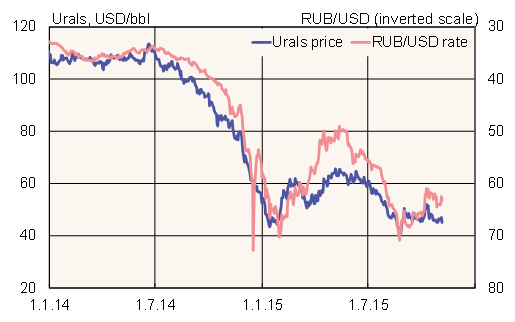BOFIT Weekly Review 45/2015
Ruble remains weak
While the ruble has recovered slightly from the low it reached at end-August on a slight rise in oil prices and fading capital outflows from Russia, the ruble-dollar rate has in past days still stood at around 63 and the ruble-euro rate around 69. Thus, the ruble is still clearly weaker than it was a year ago, having lost over 30 % of its value against the dollar and over 20 % against the euro. The ruble has also lost about a fifth of its value in real terms from a year ago in relation to both the euro and the trade-weighted currency basket of Russia’s main trading partners.
Ruble-dollar exchange rate and price of Urals crude oil

Source: Reuters
The first step towards liberalisation of ruble’s exchange rate was taken 25 years ago. Starting from November 1, 199o, the commercial ruble exchange rate was set to 1.8 rubles to the dollar by president Mikhail Gorbachev’s decree. The commercial rate (more favourable than the official exchange rate) was used in converting corporate forex income to rubles. Thereafter, the ruble’s exchange rate was gradually liberalised. In November 2014, the CBR announced it would no longer steer the ruble’s external rate.
The ruble’s use in Russia’s international payments has gradually increased. In the first half of this year, over 10 % of Russian exports and nearly 30 % of Russian imports were settled in rubles. The ruble is mainly used in trade between Russia and CIS countries, but a rather large share of Russian imports from the EU are also settled in rubles. In addition, about a fifth of Russian foreign debt is in rubles.
The ruble’s use in overall international payments remains marginal and has decreased recently. SWIFT, the provider of global financial communication services, reports that the ruble’s share of all international payments this year has been just 0.2 %, making it less popular than e.g. the Turkish lira or the South African rand.